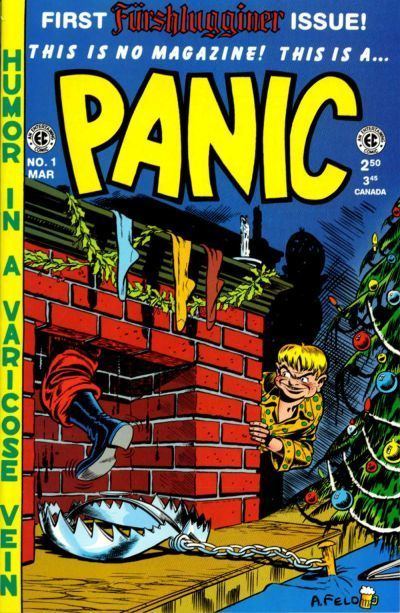 | ||
Similar Psychoanalysis, Three Dimensio, Aces High, Impact, Valor | ||
Panic was part of the EC Comics line during the mid-1950s. The bi-monthly humor comic was published by Bill Gaines as a companion to Harvey Kurtzman's Mad, which was being heavily imitated by other comic publishers.
Contents
Panic was edited by Al Feldstein (who became the editor of Mad a few years later). Beginning with its first issue (February–March 1954), Panic had a 12-issue run over two years. Feldstein was the primary cover artist, with stories illustrated by Jack Davis, Will Elder, Jack Kamen, Joe Orlando, Basil Wolverton and Wally Wood. Some story ideas were by Nick Meglin, later the co-editor of Mad. Scripts were by Feldstein, Elder and Jack Mendelsohn, later a co-screenwriter of Yellow Submarine (1968) and an Emmy-nominated TV comedy writer.
EC dubbed Panic the "only authorized imitation" of Mad, but Mad's creator didn't enjoy the joke. Almost thirty years later, Harvey Kurtzman told an interviewer, "Panic was another sore point. Gaines, by some convoluted reasoning, decided to double the profit of Mad by doing a Feldstein version of Mad and he just plundered all of my techniques and artists. For this there was a real conflict of interests."
First Issue Controversy
The publication was immediately controversial, as detailed by Steve Stiles in his article,"It's a Panic!":
What Panic also earned was a storm of indignation that burst over Gaines' head with the very first issue, and all over the holiday of "Peace on Earth, Good Will Towards Men". It's strange that Gaines didn't see it coming, but some people got very annoyed with a satire of "The Night Before Christmas". To put it mildly.Gaines later recalled, "The trouble we had on the Santa Claus story was Bill Elder. He had put a sign on the sleigh of Santa Claus, 'Just Divorced'. Now how do a bunch of iconoclastic, atheist bastards like us know that Santa Claus is a saint and that he can't be divorced and that this is going to offend Boston?" This didn't stop Gaines from later dressing in a Santa suit and posing for a Mad subscription offer as a benevolent gift giver (because the subscription rate was only a few cents cheaper than buying the issues at cover price).
As a result of the parody, Panic was ultimately banned from sale in the state of Massachusetts. Gaines puckishly responded by issuing a press release announcing that as a "retaliatory measure," EC was pulling all copies of its Picture Stories from the Bible comic book out of Massachusetts. It took the newspapers a few days to realize that the discontinued comic hadn't been on sale in Massachusetts, or anywhere else, in five years.
More legal hassles came EC's way because of another story from the first issue, a gory parody of Mickey Spillane's My Gun is the Jury that ended with one of Spillane's bombshell women revealed as a transvestite. A few days after the Santa controversy in Massachusetts, EC's offices were raided by the New York City police. Gaines' associate Lyle Stuart willingly took responsibility and was arrested; the charge was quickly thrown out of court. In the meantime, abrasive gossip columnist Walter Winchell reported the story without mentioning that Stuart was released without result, and added, "Attention all newsstands! Anyone selling the filth of Lyle Stuart will be subject to the same arrest!" Winchell may have been motivated by "The Secret Life of Walter Winchell", a negative book based on a series of negative magazine articles about him written by Stuart, but his rhetoric cost him $21,500 after Stuart sued for libel. Stuart used the money to start his own publishing house.
Differing views
Mad was quickly and widely imitated, to the point where creator and editor Harvey Kurtzman mocked his competitors' wave of copycat humor comic books in Mad's 17th issue. But he was particularly unhappy with EC's own imitation. "I was pretty bitter about it," Kurtzman said in 1965. "The publisher and I got into a series of ever-increasing arguments going around in ever diminishing circles."
Publisher Gaines rejected Kurtzman's complaint, telling an interviewer decades later:
Sometimes Harvey loses sight of the fact that this was my business, that I was publishing these magazines, that one of my magazines was Mad, that I had a lot of other magazines making more or less profits, some of them none, and what’s so immoral about me putting out another magazine imitating my own magazine? You see Harvey could never realize that Mad was mine; he thought it was his. [Laughter.] That was the basic problem. To me Mad was one of the EC Comics. If we put out The Vault of Horror and it’s successful, what’s wrong with putting out Tales From the Crypt? If we put out Mad and it’s successful, what’s wrong with putting out — all the time we put out Panic, Harvey felt we were competing with him, and I used to say, “Harvey, we’re not competing with you, we’re all one company. [Laughter.] The money comes from everywhere and it goes into a pot and from this pot we publish.” Why am I competing?
MadMadEek, Ecch, Oook, Turn BlueCrazyCrackedNuttySillyWoppyDaffyMadPanic[laughter]Reprints
Panic has been reprinted by publisher Russ Cochran several times. In 1985, it formed part of his Complete EC Library, published (in black and white) as a slipcased hardcover two-volume set. Panic was also reprinted issue-by-issue between March 1997 and December 1999 by Cochran (in association with Gemstone Publishing). This complete run was later rebound, with covers included, in three softcover EC Annuals.
